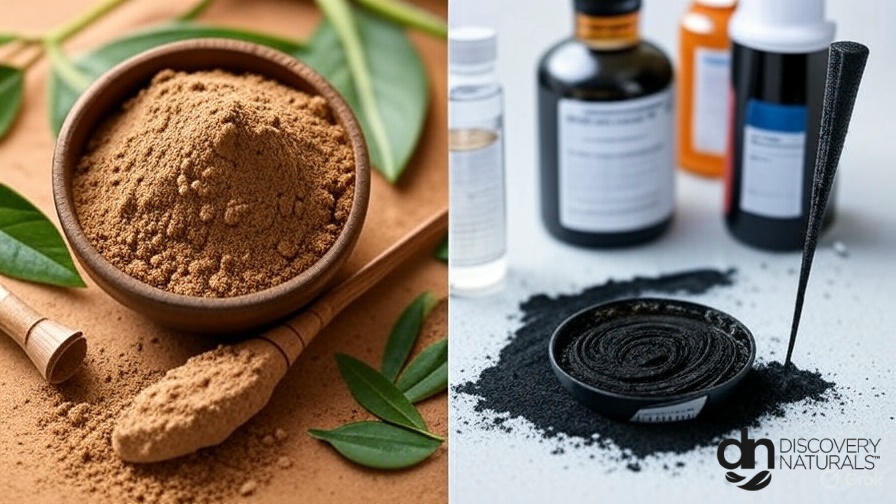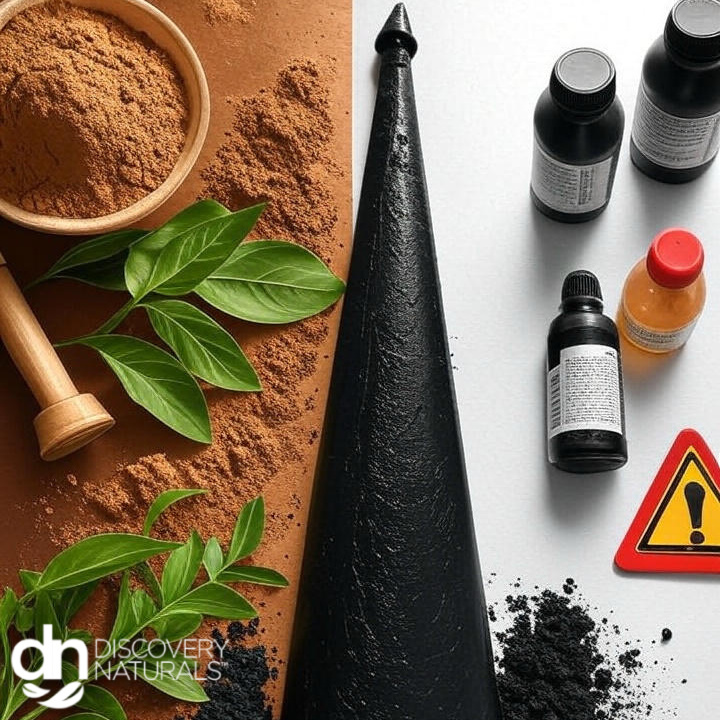Henna has become a beloved natural option for body art and hair color—but not all henna is created equal. If you’ve ever heard someone say they had an allergic reaction to henna, there’s a good chance they weren’t using real, natural henna at all. They may have used something labeled “black henna,” and that’s a very different story.
In this blog, we’ll walk you through the key differences between brown henna (natural) and black henna (chemical-laced), including safety concerns, usage tips, and how to spot the real stuff. Whether you’re applying henna for body art or hair color, this guide will help you make the safest and most informed choice.

What Is Brown Henna?
Brown henna, also called natural henna or pure henna, is made from the dried and powdered leaves of the Lawsonia inermis plant. When mixed with water, lemon juice, or tea, it creates a smooth, earthy paste that leaves a reddish-brown stain on the skin or hair.
-
Ingredients: 100% plant-based (henna leaves only)
-
Color Result: Reddish-brown
-
Skin Safety: Safe for all skin types
-
Used For: Body art, temporary tattoos, and hair coloring
Natural brown henna has been used for thousands of years in cultures around the world. It’s rich in tradition, safe, and even conditions your skin and hair.
What Is Black Henna?
Black henna is a misleading term. It’s often a mix of low-grade henna and paraphenylenediamine (PPD), a chemical used in many hair dyes. PPD helps darken the color quickly and makes it appear black—but when applied to the skin, it can be dangerous.
-
Ingredients: Henna + synthetic chemicals (especially PPD)
-
Color Result: Jet black or dark brown
-
Skin Safety: Not safe; can cause rashes, burns, and scarring
-
Used For: Tattoos and hair dye (despite FDA warnings)
⚠️ The FDA has issued warnings about the use of black henna for body art due to allergic reactions, scarring, and chemical burns.
Key Differences: Brown Henna vs. Black Henna
| Feature | Brown Henna (Natural) | Black Henna (Chemical) |
|---|---|---|
| Color | Reddish-brown | Jet black |
| Ingredients | Henna plant only | Henna + PPD + other chemicals |
| Skin Reaction | Rare, usually safe | Common; allergic reactions |
| Smell | Earthy, natural | Chemical or odorless |
| Shelf Life | 3–6 days (once mixed) | 6+ months |
| FDA Approval | Safe for body art | NOT approved for skin use |

How to Tell the Difference
Here’s how you can tell if the henna you’re using is natural or potentially dangerous:
1. Check the Ingredients
Always read the label. If it lists PPD, dye, or any chemical-sounding names—it’s not pure henna.
2. Smell Test
Natural henna smells like earth or crushed leaves. Black henna often smells synthetic or has no scent at all.
3. Color Claims
If the paste promises a deep black stain in under 30 minutes—run. Natural henna needs at least 4–6 hours and stains reddish brown.
4. Shelf Life
Real henna paste has a short life span. If it’s been sitting in a tube or cone for months and still claims to work—it likely contains preservatives or chemicals.
Want to learn more? Read our Step-by-Step Henna Application Guide.
Is Black Henna Safe for Hair?
PPD is used in many hair dyes but must be handled with care and used according to specific safety standards. When applied casually or directly to the skin, it can be harmful. If you see black henna being sold as a hair dye, always patch test and ensure it’s free from PPD.
We always recommend using brown henna blended with indigo if you want darker hair results the natural way.
Learn more in How to choose the right henna shade for your hair?.
Benefits of Brown Henna (Natural Henna)
-
Strengthens and conditions the hair
-
Soothes the scalp
-
Adds natural shine
-
Safe for sensitive skin
-
Naturally antimicrobial
FAQs: Brown vs. Black Henna
Is black henna safe for the skin?
No. Black henna often contains PPD, which can cause burns, rashes, and long-term sensitivity.
Why is natural henna brown, not black?
Henna’s natural dye compound (lawsone) stains a reddish-brown color. There’s no plant-based alternative that stains true black without added chemicals.
How long does brown henna last on the skin?
Typically 4–7 days, depending on placement, aftercare, and your skin type.
Can I get darker results with natural henna?
Yes—try layering with indigo or using coffee, tea, or essential oils to deepen the tone naturally.
Where can I buy real, safe henna?
Right here at Henna King! Our products are made from 100% pure henna with no added chemicals.
When it comes to choosing between brown henna and black henna, the answer is clear: natural is best. Black henna may offer fast results, but the risks are simply not worth it. Brown henna is time-tested, plant-based, and safe for both body and hair.
If you care about your skin, your health, and the long-term results—choose pure henna from a trusted source. Choose Henna King.
Explore our Natural Henna Products to get started today.
